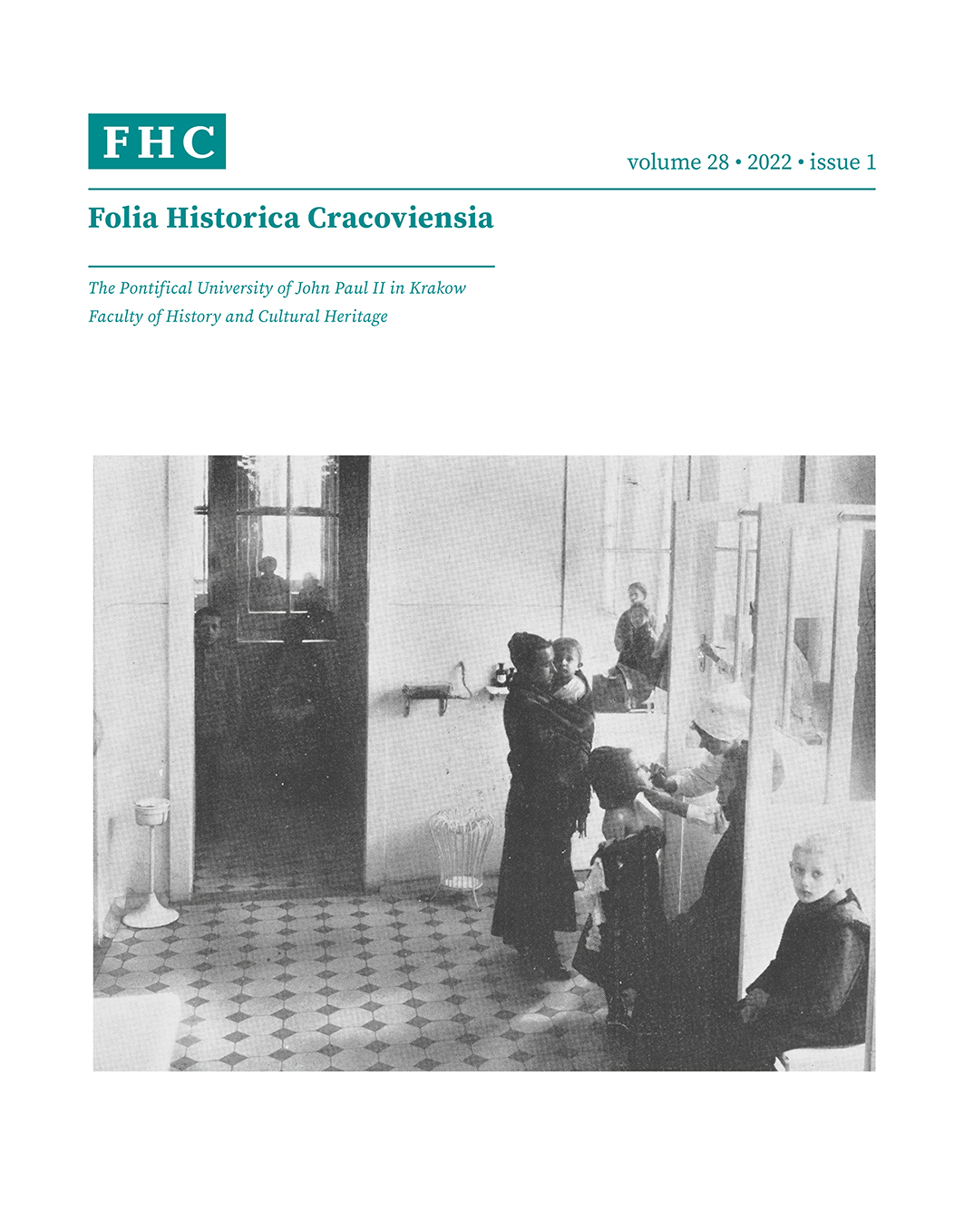Heretycy jako słudzy diabła. Konstrukcja religijnej odmienności w śląskich źródłach historiograficznych późnego średniowiecza
DOI:
https://doi.org/10.15633/fhc.28102Słowa kluczowe:
herezja, Śląsk, husytyzm, źródła narracyjne, Jan HusAbstrakt
Już od czasów św. Augustyna społeczeństwo średniowieczne było głęboko przekonane o związku herezji z diabłem, a heretyków często uważano za członków civitatis diaboli. W środowisku śląskim z podobnie skonstruowaną tożsamością religijną częściej można się spotkać w późnym średniowieczu, kiedy społeczeństwo śląskie stanęło w obliczu zagrożenia husytyzmem. Powyższe znalazło odzwierciedlenie w pracach ówczesnych kronikarzy (np. Petera Eschenloera, Caspara Borgeniego, Johannesa Frobena i innych). Opisy heretyków tworzone były zgodnie z istniejącą już tradycją chrześcijańską i w przeważającej mierze składały się ze stereotypów i toposów związanych z herezją. Artykuł skupia się na analizie strategii narracyjnych stosowanych przez śląskich kronikarzy i stara się wyjaśnić, w jaki sposób kreowali oni obraz heretyków, z naciskiem na rolę, jaką w tych opisach odgrywał diabeł.
Bibliografia
Annales Glogovienses bis z. J. 1493. Nebst urkundlichen Beilagen, ed. by H. Markgraf, Breslau 1877 (Scriptores Rerum Silesiacarum, 10).
Bruschi C., Biller P., Text and the Repression of medieval Heresy: Introduction, in: Text and the Repression of medieval Heresy, ed. by C. Bruschi, P. Biller, York 2002.
Čapský M., Prix D., Slezsko v pozdním středověku (do roku 1490), in: Slezsko v dějinách českého státu, vol. 1: Od pravěku do roku 1490, ed. by Z. Jirásek, Praha 2012, pp. 261–430.
Čapský M., Město pod vládou kazatelů. Charizmatičtí náboženští vůdci ve střetu s městskou radou v pozdně středověkých českých korunních zemích, Praha 2015.
Chronik des Martin von Bolkenheim, in: Geschichtschreiber Schlesiens des XV. Jahrhunderts, ed. by F. Wachter, Breslau 1883 (Scriptores Rerum Silesiacarum, 12).
Čornej P., Bartlová M., Velké dějiny zemí Koruny české, vol. 6: 1437–1526, Praha–Litomyšl 2007.
Czarnecki R., Kronika Namysłówa autorstwa Johannesa Frobena jako utwór dziejopisarstwa miejskiego, Warszawa 2015.
Delumeau J., Strach na západě ve 14. – 18. století, part 2: Obležená obec, Praha 1999.
Drabina J., Rola argumentacji religijnej w walce politycznej w późnośredniowiecznym Wrocławiu, Kraków 1984.
Eschenloer P., Geschichte der Stadt Breslau, part 1: Chronik bis 1466, part 2:
Chronik ab 1467, ed. by G. Roth, New York–München–Berlin 2003.
Filip V., Borchardt K., Schlesien, Georg von Podiebrad und die römische Kurie, Würzburg 2005.
Grundmann H., Der Typus des Ketzers in mittelalterlicher Anschauung, in: Kultur- und Universalgeschichte: Walter Goetz zu seinem 60. Geburtstage, Leipzig–Berlin 1927, pp. 91–107.
Grünhagen C., Die Hussitenkämpfe der Schlesier, Breslau 1872.
Iwańczak W., Piotr Eschenloer – świadek epoki, in: Tysiącletnie dziedzictwo kulturowe diecezji wrocławskiej, ed. by A. Barciak, Katowice 2000, pp. 160–170.
Iwańczak W., Táborité v polské historiografii 19. a začátku 20. století, “Husitský Tábor” 12 (1999), pp. 69–75.
Jan Hus, Knížky o svatokupectví, ed. by J. Hrabák, Praha 1954.
Knoetel P., Der Verfasser der “Annales Glogovienses”, “Zeitschrift des Vereins für Geschichte und Alterthum Schlesiens” 22 (1888), pp. 94–109.
Machilek F., Ludolf von Sagan und seine Stellung in der Auseinandersetzung um Konziliarismus und Hussitismus, München 1967.
Mrozowicz W., Regional identity in Silesia (until 1526), in: The Long Formation of the Region Silesia (c. 1000–1526) ed. by P. Wiszewski, Wrocław 2013, pp. 215–237.
Muchembled R., Dějiny ďábla, Praha 2008.
Pastoreau M., Dějiny symbolů v kultuře středověkého západu, Praha 2018.
Patchowsky A., Bludiště pravé víry: Sektáři, kacíři a reformátoři ve středověkých Čechách, Praha 2018.
Potkowski E., Stereotyp heretyka–innowiercy w piśmiennictwie kaznodziejskim, in: Kultura elitarna a kultura masowa w Polsce późnego średniowiecza, ed. by B. Geremek, Wrocław 1978, pp. 121–135.
Proces beginek świdnickich w 1332 roku. Studia historyczne i edycja łacińsko-
-polska, ed. by P. Kras, T. Gałuszka OP, A. Poznanski, Lublin 2017.
Radek D., Bolek V. Opolský. Život a legenda (okolo 1400–1460), Opava 2018.
Ratiborer Chronik (ed. by A. Weltzel), “Zeitschrift des Vereins für Geschichte und Alterthum Schlesiens” 4 (1862), pp. 114–126.
Roth G., ’Wider die Anfechtungen der Ketzer’. Nikolaus Tempelfelds Traktat Ordo nature et racionis in der Übersetzung durch Peter Eschenloer. Edition und Erläuterungen, “Zeitschrift für Ostmitteleuropa-Forschung” 69 (2020), pp. 209–254.
Sigismundi Rosiczii chronica et numerus episcoporum Wratislaviensium itemque gesta diversa transactis temporibus facta in Silesia et alibi. Ab anno C. 1051 usque 1470, in: Geschichtschreiber Schlesiens des XV. Jahrhunderts, ed. by F. Wachter, Breslau 1883 (Scriptores Rerum Silesiacarum, 12).
Šmahel F., Husitská revoluce, vol. 1–4, Praha 1995–1996.
Šmahel F., Život a dílo Jeronýma Pražského, Praha 2010.
Soukup P., Jan Hus. Život a smrt kazatele, Praha 2015.
Szymański J., Ruchy heretyckie na Śląsku w XIII i XIV wieku, Katowice–Kraków 2007.
Urbánek R., Věk poděbradský, vol. 3, Praha 1930.
Výzva Jana Želivského. Výbor z kázání, ed. by A. Molnár, Praha 1954.
Zilynská B., Synodální opatření proti husitům v diecézích širší střední Evropy, in: Ve znamení Koruny české. Sborník k šedesátým narozeninám prof. PhDr. Lenky Bobkové, CSc., eds. L. Březina, J. Konvičná, J. Zdichynec, Praha 2006, pp. 265–288.
Żerelik R., Dzieje Śląska do 1526 roku, in: Historia Śląska, ed. by M. Czapliński, Wrocław 2002, pp. 98–118.
Pobrania
Opublikowane
Numer
Dział
Licencja

Utwór dostępny jest na licencji Creative Commons Uznanie autorstwa 4.0 Międzynarodowe.
Autorzy publikujący w czasopiśmie udzielają jego wydawcy zgody o następującej treści:
- Autor zachowuje autorskie prawa majątkowe do utworu, a jednocześnie udziela wydawcy czasopisma zgody na jego pierwszą publikację w wersji drukowanej i wersji online na licencji Creative Commons Uznanie autorstwa 4.0 Międzynarodowe oraz zgody na wykonywanie opracowań, w tym przekładów.
- Autor ma możliwość udzielania zgody niewyłącznej na opublikowanie utworu w wersji, która ukazała się w czasopiśmie (np. zamieszczenia go w repozytorium instytucjonalnym lub opublikowania w książce), wraz z informacją o jego pierwszej publikacji w czasopiśmie.
- Autor może umieścić swój utwór online (np. w repozytorium instytucjonalnym lub na swojej stronie internetowej) jeszcze przed zgłoszeniem utworu do czasopisma.

